2016 TOYOTA PRIUS V belt
[x] Cancel search: beltPage 70 of 620
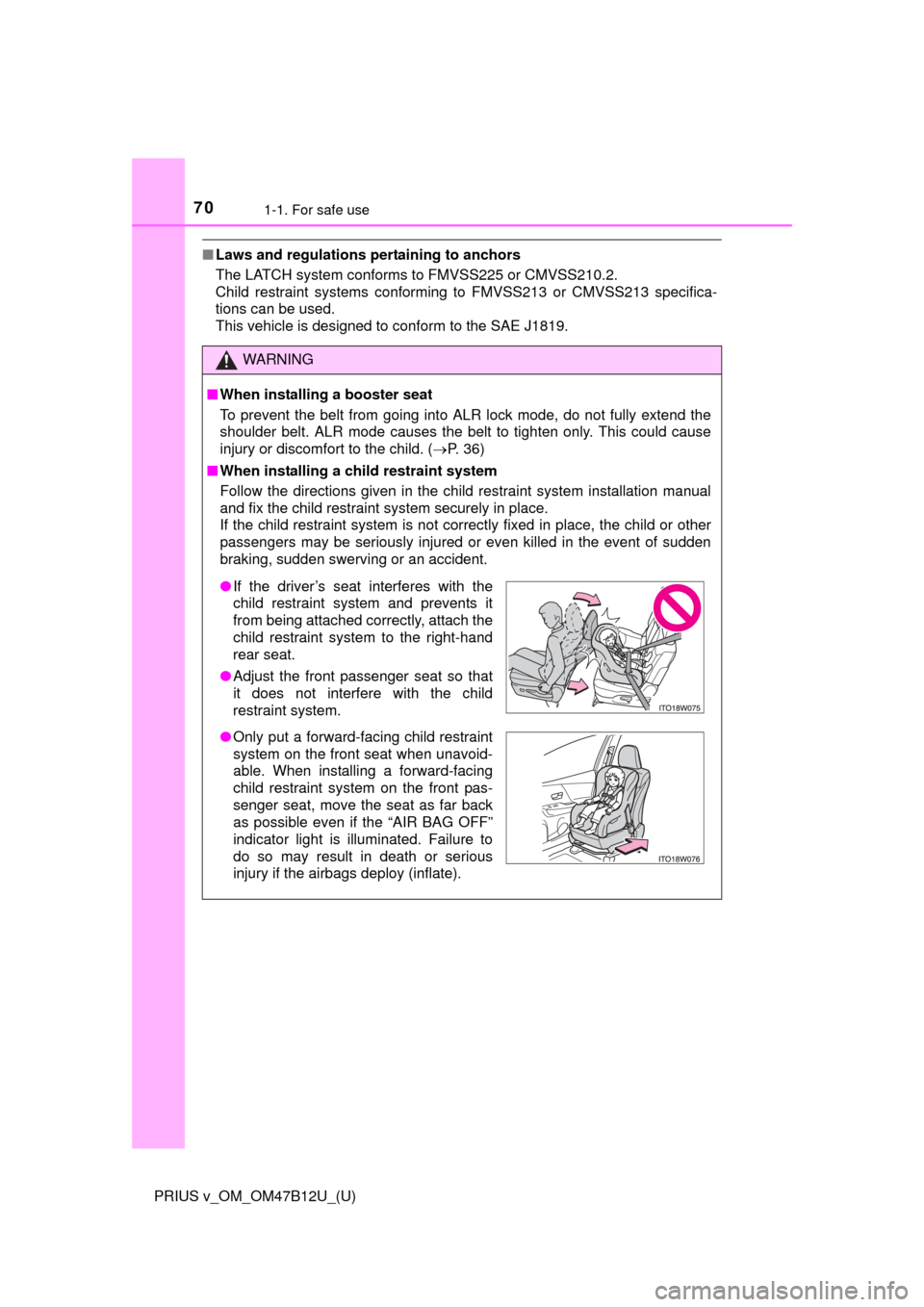
701-1. For safe use
PRIUS v_OM_OM47B12U_(U)
■Laws and regulations pertaining to anchors
The LATCH system conforms to FMVSS225 or CMVSS210.2.
Child restraint systems conforming to FMVSS213 or CMVSS213 specifica-
tions can be used.
This vehicle is designed to conform to the SAE J1819.
WARNING
■When installing a booster seat
To prevent the belt from going into ALR lock mode, do not fully extend the
shoulder belt. ALR mode causes the belt to tighten only. This could cause
injury or discomfort to the child. (P. 36)
■When installing a child restraint system
Follow the directions given in the child restraint system installation manual
and fix the child restraint system securely in place.
If the child restraint system is not correctly fixed in place, the child or other
passengers may be seriously injured or even killed in the event of sudden
braking, sudden swerving or an accident.
●If the driver’s seat interferes with the
child restraint system and prevents it
from being attached correctly, attach the
child restraint system to the right-hand
rear seat.
●Adjust the front passenger seat so that
it does not interfere with the child
restraint system.
●Only put a forward-facing child restraint
system on the front seat when unavoid-
able. When installing a forward-facing
child restraint system on the front pas-
senger seat, move the seat as far back
as possible even if the “AIR BAG OFF”
indicator light is illuminated. Failure to
do so may result in death or serious
injury if the airbags deploy (inflate).
Page 71 of 620
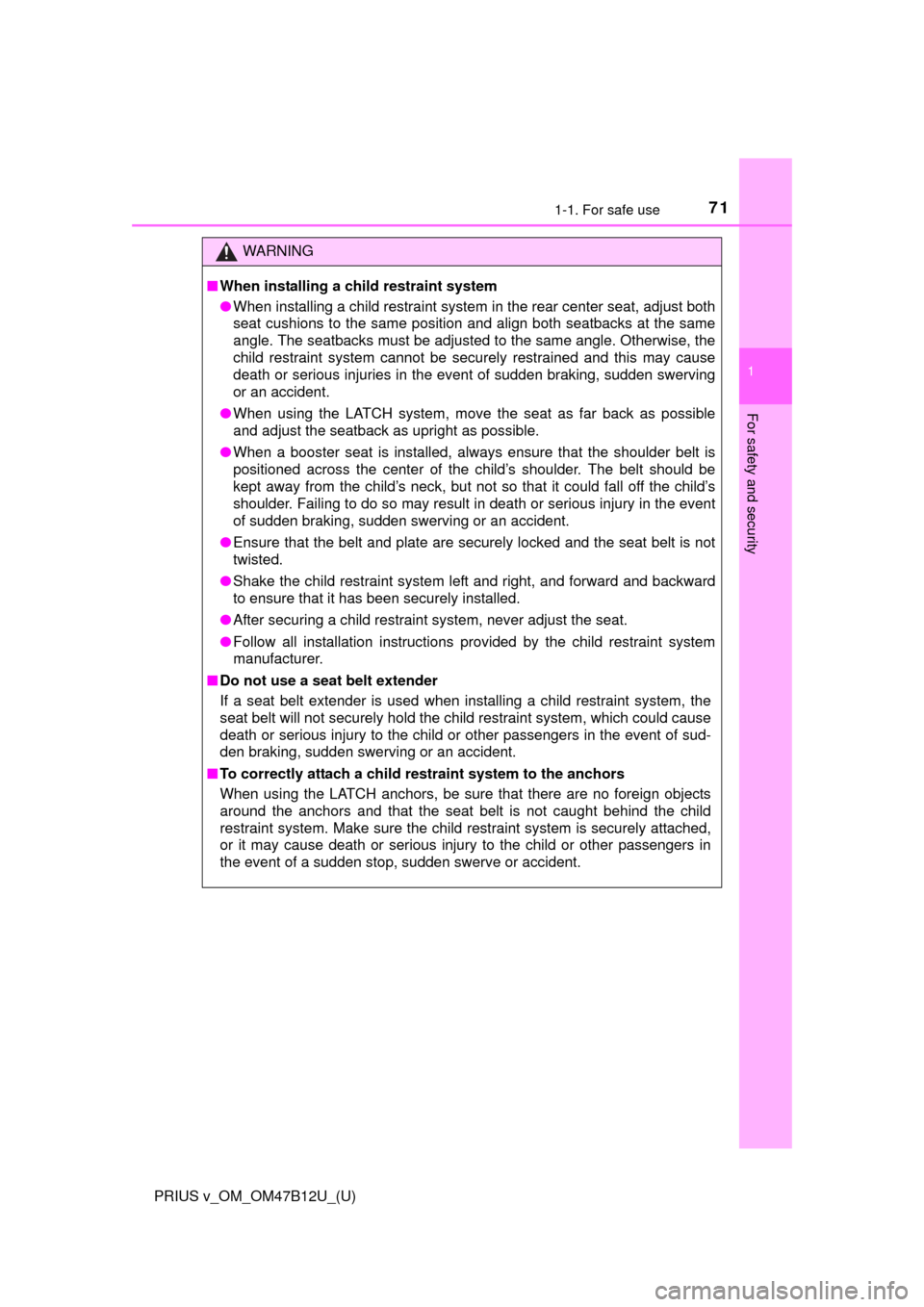
711-1. For safe use
PRIUS v_OM_OM47B12U_(U)
1
For safety and security
WARNING
■When installing a child restraint system
●When installing a child restraint system in the rear center seat, adjust both
seat cushions to the same position and align both seatbacks at the same
angle. The seatbacks must be adjusted to the same angle. Otherwise, the
child restraint system cannot be securely restrained and this may cause
death or serious injuries in the event of sudden braking, sudden swerving
or an accident.
●When using the LATCH system, move the seat as far back as possible
and adjust the seatback as upright as possible.
●When a booster seat is installed, always ensure that the shoulder belt is
positioned across the center of the child’s shoulder. The belt should be
kept away from the child’s neck, but not so that it could fall off the child’s
shoulder. Failing to do so may result in death or serious injury in the event
of sudden braking, sudden swerving or an accident.
●Ensure that the belt and plate are securely locked and the seat belt is not
twisted.
●Shake the child restraint system left and right, and forward and backward
to ensure that it has been securely installed.
●After securing a child restraint system, never adjust the seat.
●Follow all installation instructions provided by the child restraint system
manufacturer.
■Do not use a seat belt extender
If a seat belt extender is used when installing a child restraint system, the
seat belt will not securely hold the child restraint system, which could cause
death or serious injury to the child or other passengers in the event of sud-
den braking, sudden swerving or an accident.
■To correctly attach a child restraint system to the anchors
When using the LATCH anchors, be sure that there are no foreign objects
around the anchors and that the seat belt is not caught behind the child
restraint system. Make sure the child restraint system is securely attached,
or it may cause death or serious injury to the child or other passengers in
the event of a sudden stop, sudden swerve or accident.
Page 88 of 620
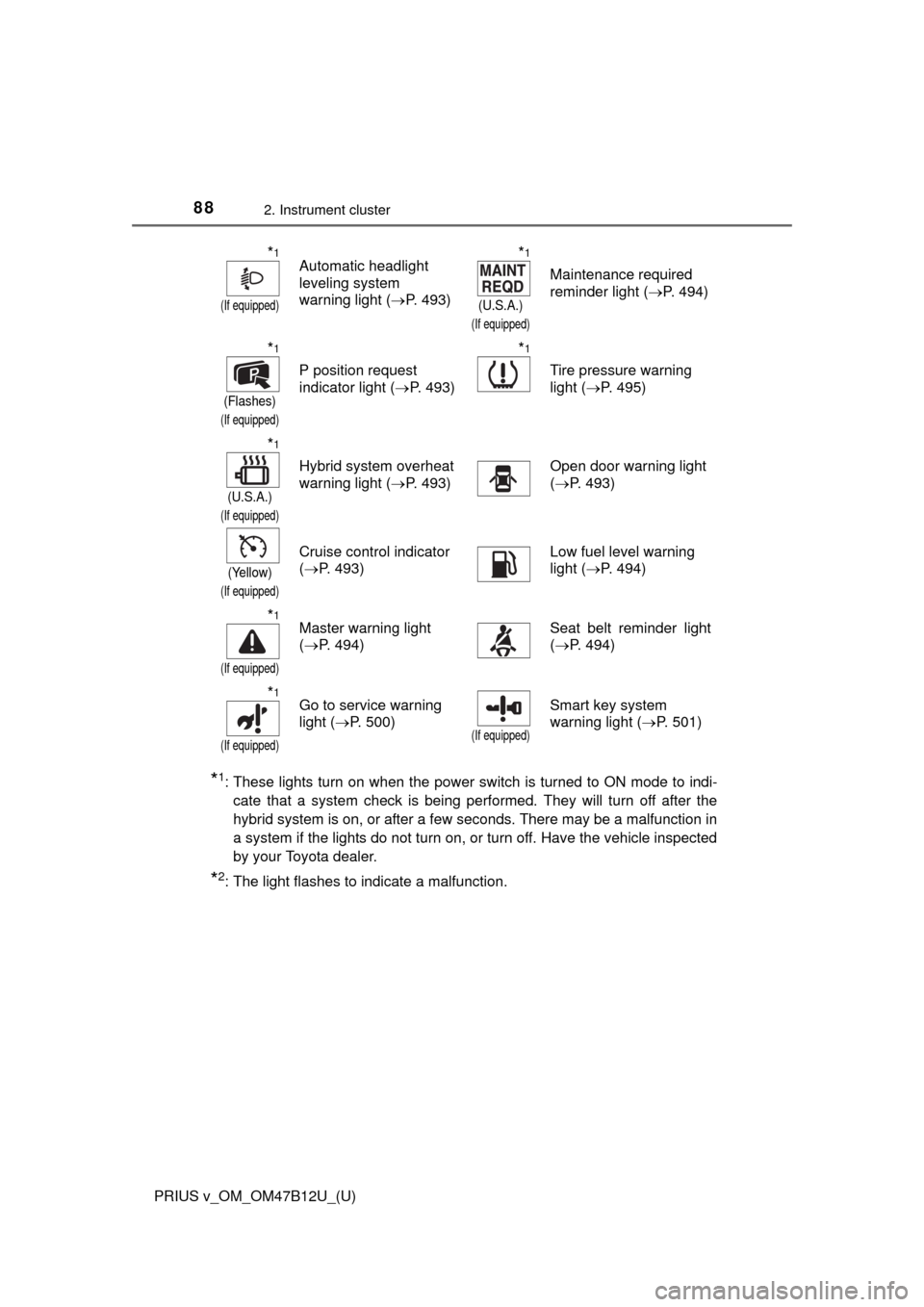
88
PRIUS v_OM_OM47B12U_(U)
2. Instrument cluster
*1: These lights turn on when the power switch is turned to ON mode to indi-
cate that a system check is being performed. They will turn off after the
hybrid system is on, or after a few seconds. There may be a malfunction in
a system if the lights do not turn on, or turn off. Have the vehicle inspected
by your Toyota dealer.
*2: The light flashes to indicate a malfunction.
*1
(If equipped)
Automatic headlight
leveling system
warning light (P. 493)*1
(U.S.A.)
(If equipped)
Maintenance required
reminder light (P. 494)
*1
(Flashes)
(If equipped)
P position request
indicator light (P. 493)
*1
Tire pressure warning
light (P. 495)
*1
(U.S.A.)
(If equipped)
Hybrid system overheat
warning light (P. 493)Open door warning light
(P. 493)
(Yellow)
(If equipped)
Cruise control indicator
(P. 493)Low fuel level warning
light (P. 494)
*1
(If equipped)
Master warning light
(P. 494)Seat belt reminder light
(P. 494)
*1
(If equipped)
Go to service warning
light (P. 500)
(If equipped)
Smart key system
warning light (P. 501)
Page 140 of 620
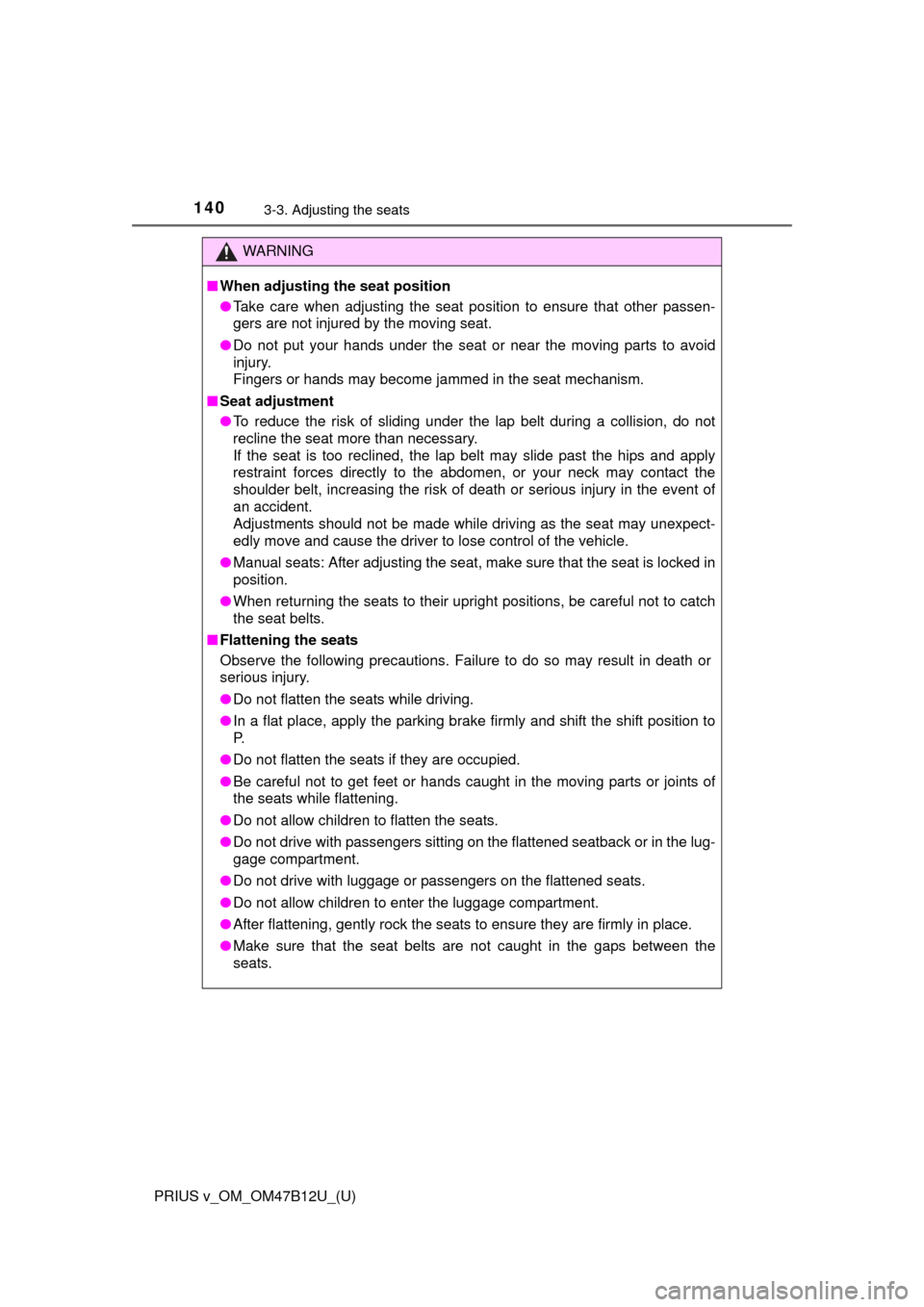
140
PRIUS v_OM_OM47B12U_(U)
3-3. Adjusting the seats
WARNING
■When adjusting the seat position
●Take care when adjusting the seat position to ensure that other passen-
gers are not injured by the moving seat.
●Do not put your hands under the seat or near the moving parts to avoid
injury.
Fingers or hands may become jammed in the seat mechanism.
■Seat adjustment
●To reduce the risk of sliding under the lap belt during a collision, do not
recline the seat more than necessary.
If the seat is too reclined, the lap belt may slide past the hips and apply
restraint forces directly to the abdomen, or your neck may contact the
shoulder belt, increasing the risk of death or serious injury in the event of
an accident.
Adjustments should not be made while driving as the seat may unexpect-
edly move and cause the driver to lose control of the vehicle.
●Manual seats: After adjusting the seat, make sure that the seat is locked in
position.
●When returning the seats to their upright positions, be careful not to catch
the seat belts.
■Flattening the seats
Observe the following precautions. Failure to do so may result in death or
serious injury.
●Do not flatten the seats while driving.
●In a flat place, apply the parking brake firmly and shift the shift position to
P.
●Do not flatten the seats if they are occupied.
●Be careful not to get feet or hands caught in the moving parts or joints of
the seats while flattening.
●Do not allow children to flatten the seats.
●Do not drive with passengers sitting on the flattened seatback or in the lug-
gage compartment.
●Do not drive with luggage or passengers on the flattened seats.
●Do not allow children to enter the luggage compartment.
●After flattening, gently rock the seats to ensure they are firmly in place.
●Make sure that the seat belts are not caught in the gaps between the
seats.
Page 142 of 620
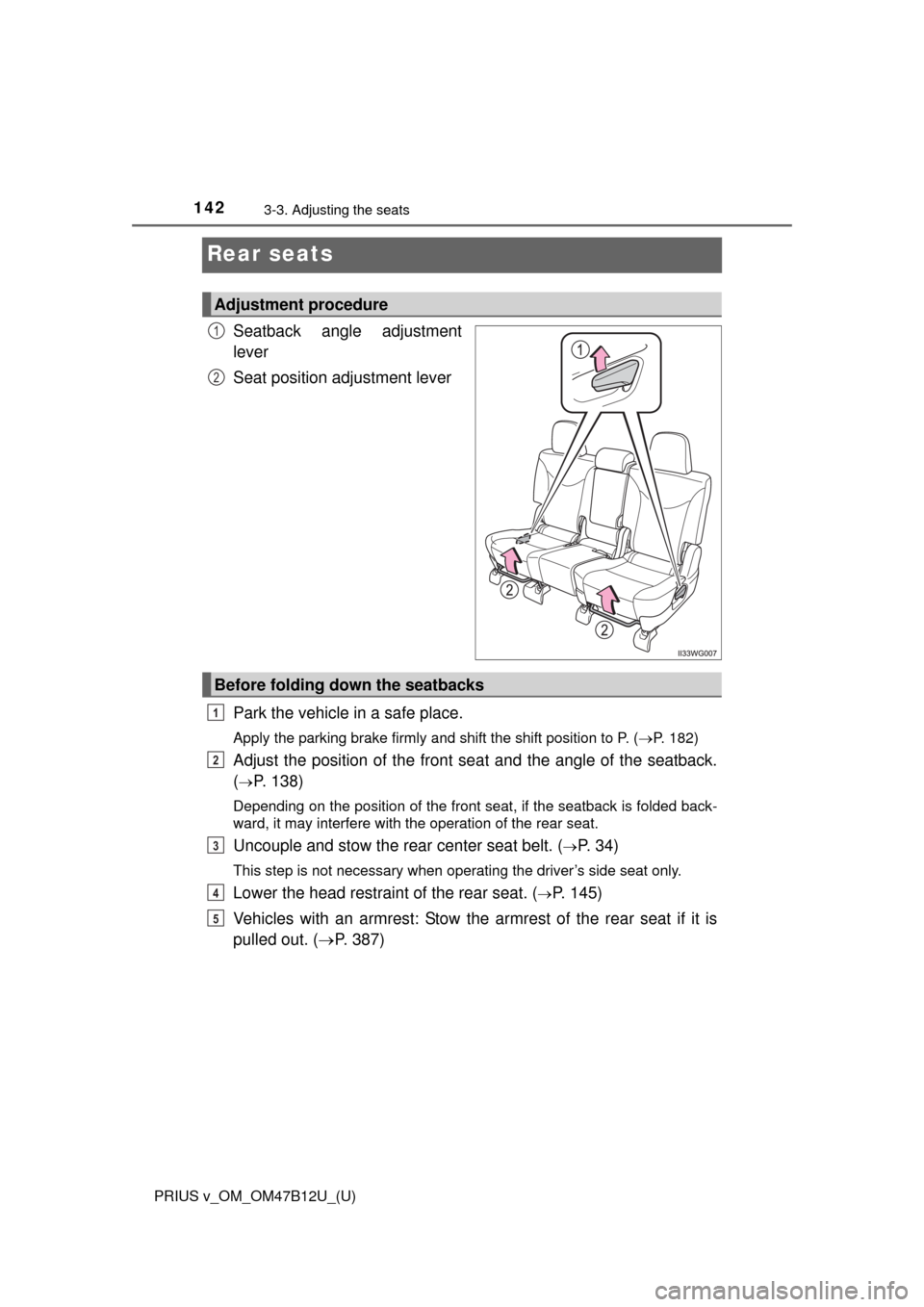
142
PRIUS v_OM_OM47B12U_(U)
3-3. Adjusting the seats
Rear seats
Seatback angle adjustment
lever
Seat position adjustment lever
Park the vehicle in a safe place.
Apply the parking brake firmly and shift the shift position to P. (P. 182)
Adjust the position of the front seat and the angle of the seatback.
(
P. 138)
Depending on the position of the front seat, if the seatback is folded back-
ward, it may interfere with the operation of the rear seat.
Uncouple and stow the rear center seat belt. (P. 34)
This step is not necessary when operating the driver’s side seat only.
Lower the head restraint of the rear seat. (P. 145)
Vehicles with an armrest: Stow the armrest of the rear seat if it is
pulled out. (P. 387)
Adjustment procedure
1
2
Before folding down the seatbacks
1
2
3
4
5
Page 143 of 620
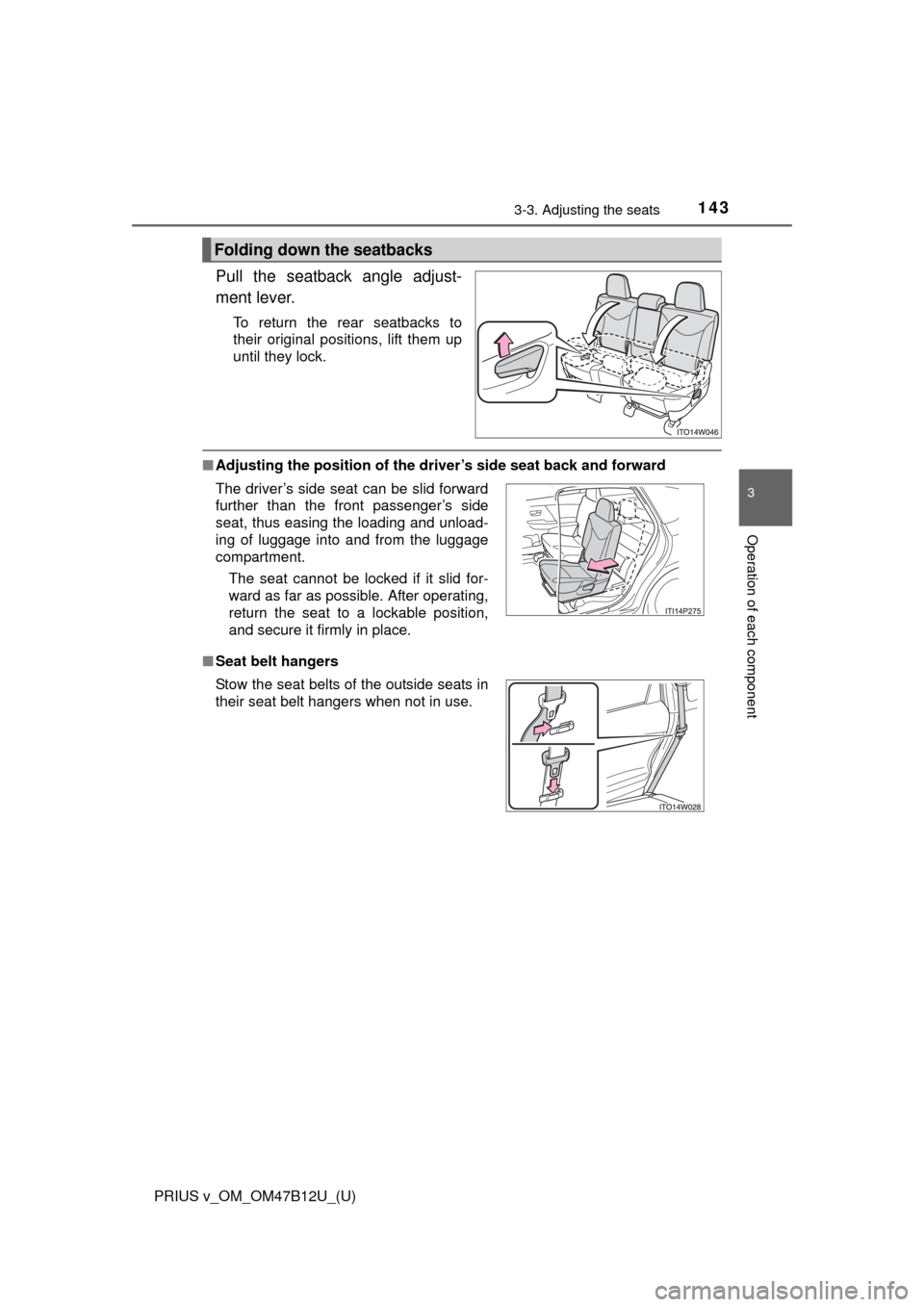
PRIUS v_OM_OM47B12U_(U)
1433-3. Adjusting the seats
3
Operation of each component
Pull the seatback angle adjust-
ment lever.
To return the rear seatbacks to
their original positions, lift them up
until they lock.
■Adjusting the position of the driver’s side seat back and forward
■Seat belt hangers
Folding down the seatbacks
The driver’s side seat can be slid forward
further than the front passenger’s side
seat, thus easing the loading and unload-
ing of luggage into and from the luggage
compartment.
The seat cannot be locked if it slid for-
ward as far as possible. After operating,
return the seat to a lockable position,
and secure it firmly in place.
Stow the seat belts of the outside seats in
their seat belt hangers when not in use.
Page 144 of 620

144
PRIUS v_OM_OM47B12U_(U)
3-3. Adjusting the seats
WARNING
■When folding the seatbacks down
Observe the following precautions. Failure to do so may result in death or
serious injury.
●Do not fold the seatbacks down while driving.
●Stop the vehicle on level ground, apply the parking brake firmly and shift
the shift position to P.
●Do not allow anyone to sit on a folded seatback or in the luggage compart-
ment while driving.
●Do not allow children to enter the luggage compartment.
●Do not operate the rear seat if it is occupied.
●Be careful not to get feet or hands caught in the moving parts or joints of
the seats during operation.
●Do not allow children to operate the seat.
●After operation, rock the seat gently to ensure that it is firmly in place.
■Reclining adjustment
●To reduce the risk of sliding under the lap belt during a collision, do not
recline the seat more than necessary.
If the seat is too reclined, the lap belt may slide past the hips and apply
restraint forces directly to the abdomen, or your neck may contact the
shoulder belt, increasing the risk of death or serious injury in the event of
an accident.
Adjustments should not be made while driving as the seat may unexpect-
edly move and cause the driver to lose control of the vehicle.
●After adjusting the seat, make sure that the seat is locked in position.
■After returning the seatback to the upright position
Observe the following precautions. Failure to do so may result in death or
serious injury.
●Make sure that the seatback is securely locked in position by lightly push-
ing it back and forth.
●Check that the seat belts are not twisted or caught in the seatback.
●Re-couple the rear center seat belt if it has been uncoupled. (P. 33)
●If the seat belt has been stowed using the seat belt hanger, check that the
seat belt has been removed from the hanger. (P. 143)
Page 169 of 620
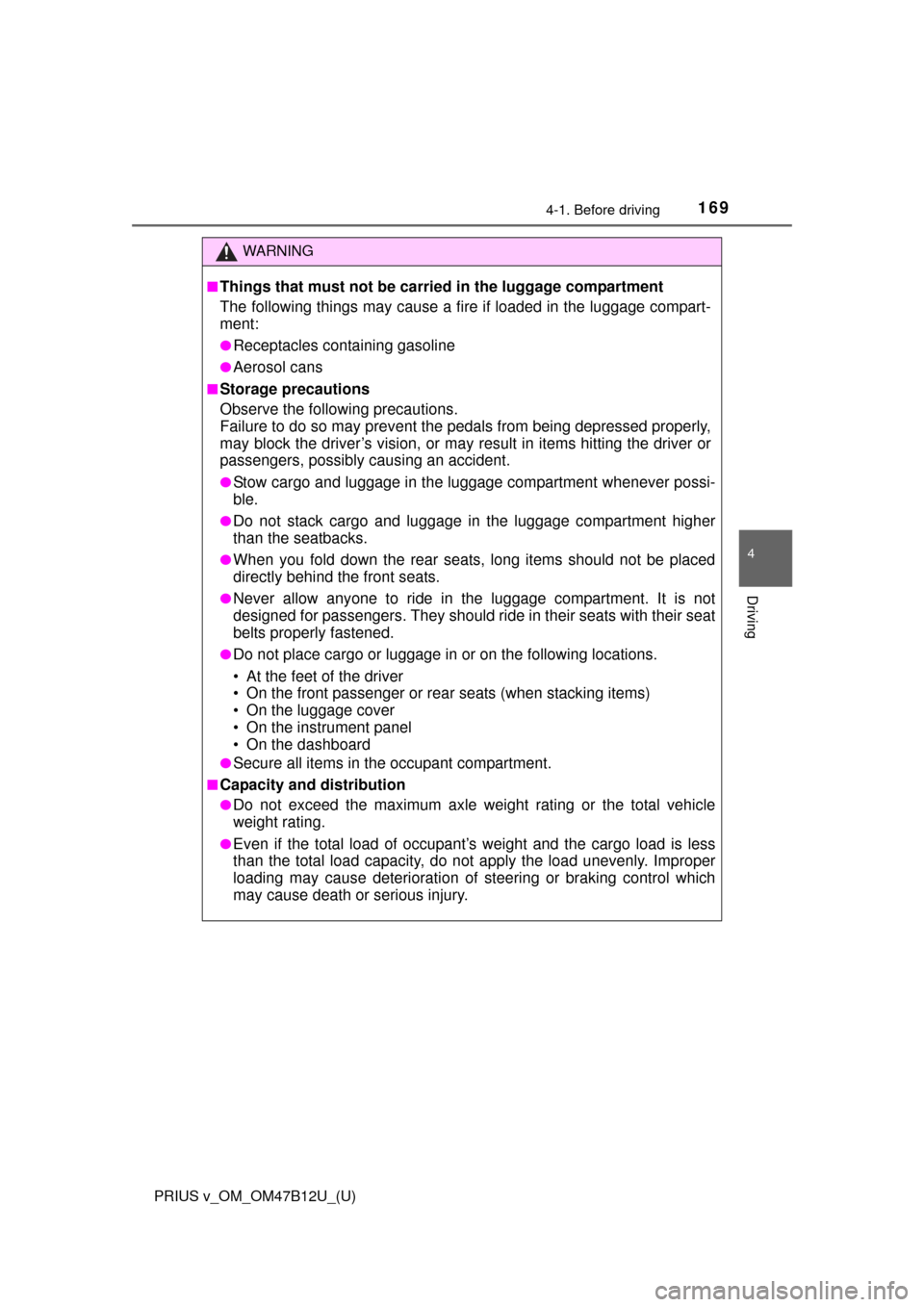
PRIUS v_OM_OM47B12U_(U)
1694-1. Before driving
4
Driving
WARNING
■Things that must not be carried in the luggage compartment
The following things may cause a fire if loaded in the luggage compart-
ment:
●Receptacles containing gasoline
●Aerosol cans
■Storage precautions
Observe the following precautions.
Failure to do so may prevent the pedals from being depressed properly,
may block the driver’s vision, or may result in items hitting the driver or
passengers, possibly causing an accident.
●Stow cargo and luggage in the luggage compartment whenever possi-
ble.
●Do not stack cargo and luggage in the luggage compartment higher
than the seatbacks.
●When you fold down the rear seats, long items should not be placed
directly behind the front seats.
●Never allow anyone to ride in the luggage compartment. It is not
designed for passengers. They should ride in their seats with their seat
belts properly fastened.
●Do not place cargo or luggage in or on the following locations.
• At the feet of the driver
• On the front passenger or rear seats (when stacking items)
• On the luggage cover
• On the instrument panel
• On the dashboard
●Secure all items in the occupant compartment.
■Capacity and distribution
●Do not exceed the maximum axle weight rating or the total vehicle
weight rating.
●Even if the total load of occupant’s weight and the cargo load is less
than the total load capacity, do not apply the load unevenly. Improper
loading may cause deterioration of steering or braking control which
may cause death or serious injury.